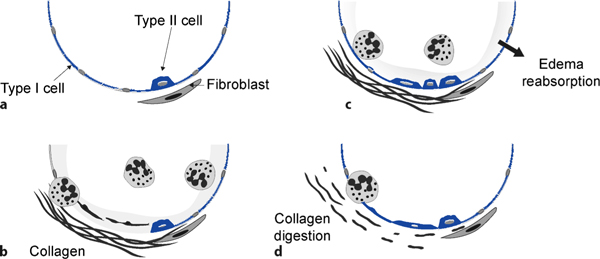Figure 1.

Overview of the injury and repair mechanisms in an alveolus. (a) The normal alveolus is formed by type I and type II alveolar cells. The former cover the majority of the alveolar area, and the latter are reduced in number. (b) After acute lung injury, the inflammatory response results in the recruitment of neutrophils from the circulation, the development of alveolar edema and the deposition of collagen fibers. The necrotic alveolar cells are detached from the basement membrane. (c) During the repair phase, the alveolar fluid is reabsorbed, the inflammatory response attenuated, and type II alveolar cells (among others) proliferate and differentiate into type I pneumocytes. In this phase, collagen fibers may facilitate cellular migration. (d) Finally, digestion of the collagen scar is needed for complete normalization of lung functions.
